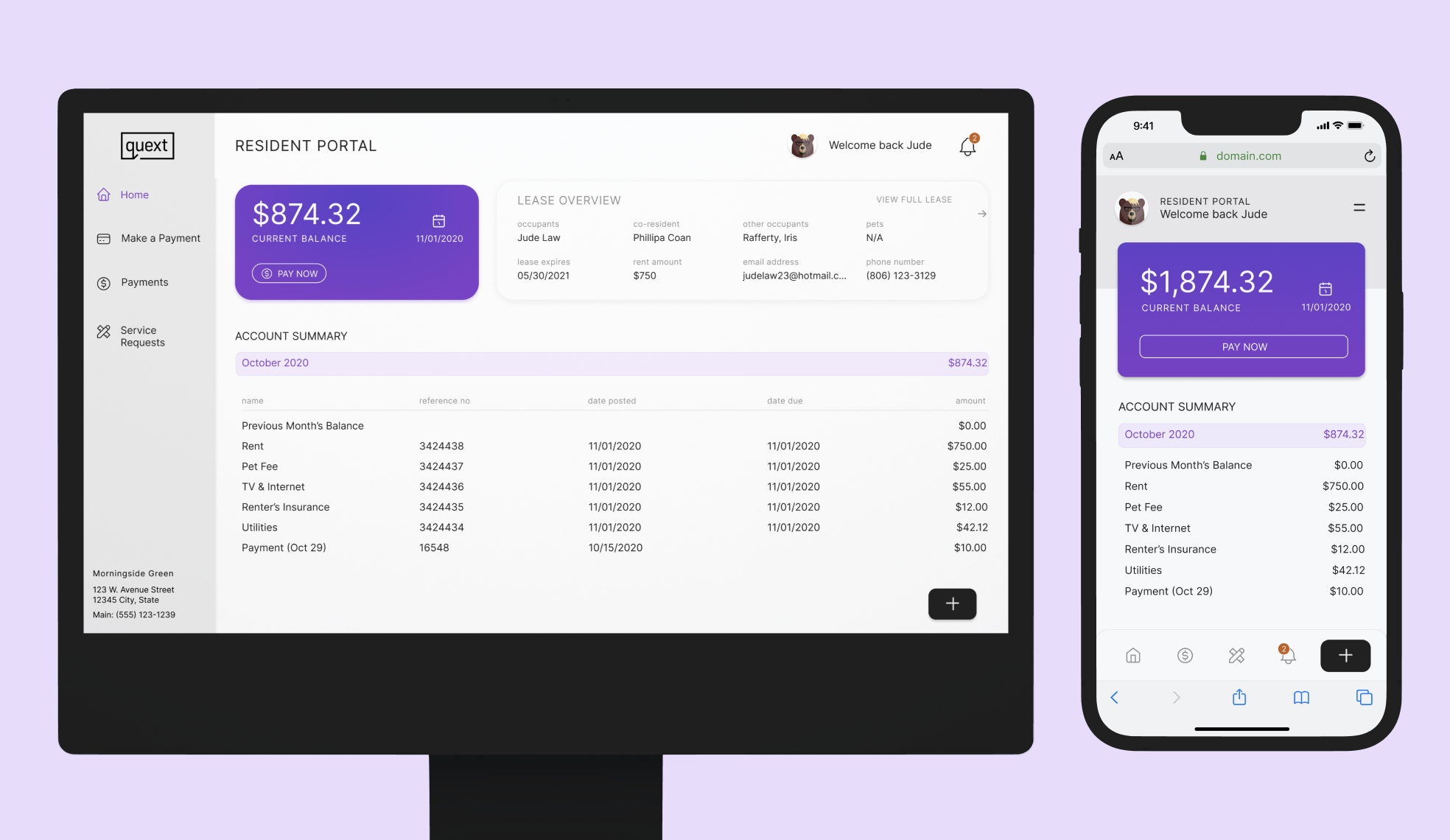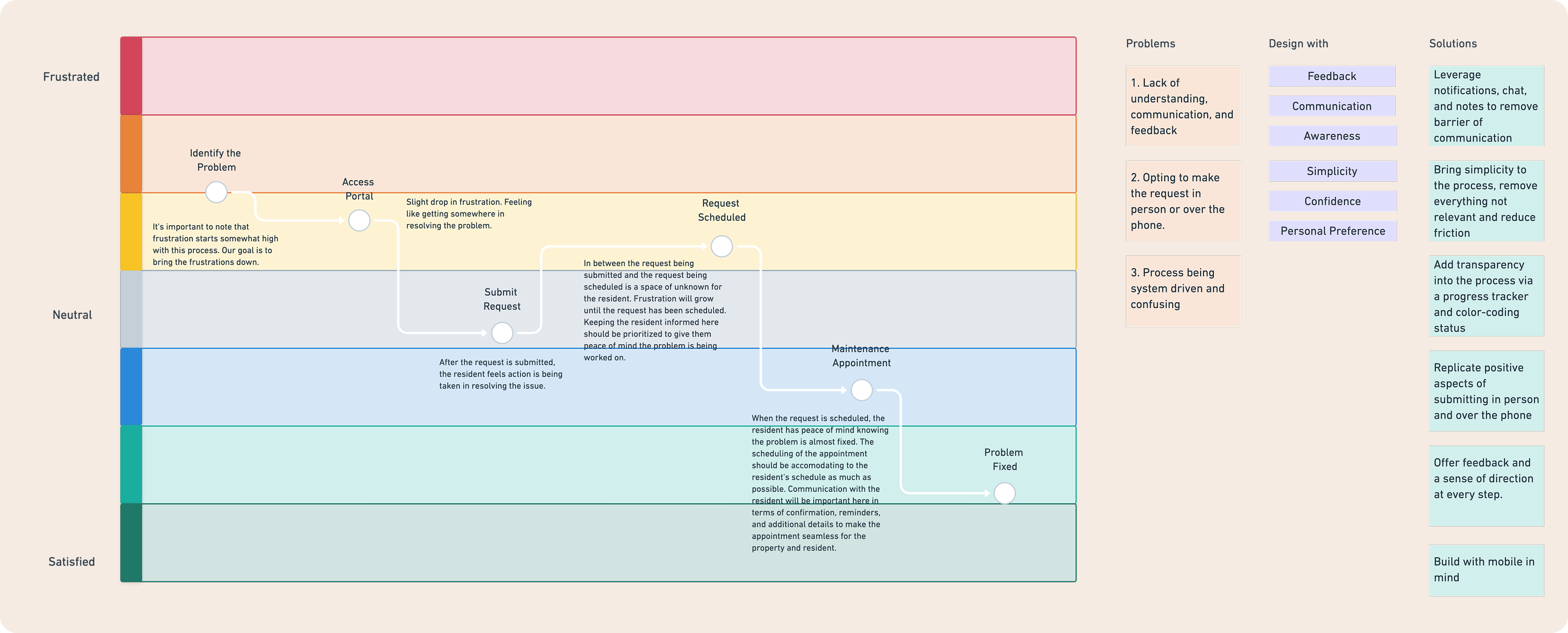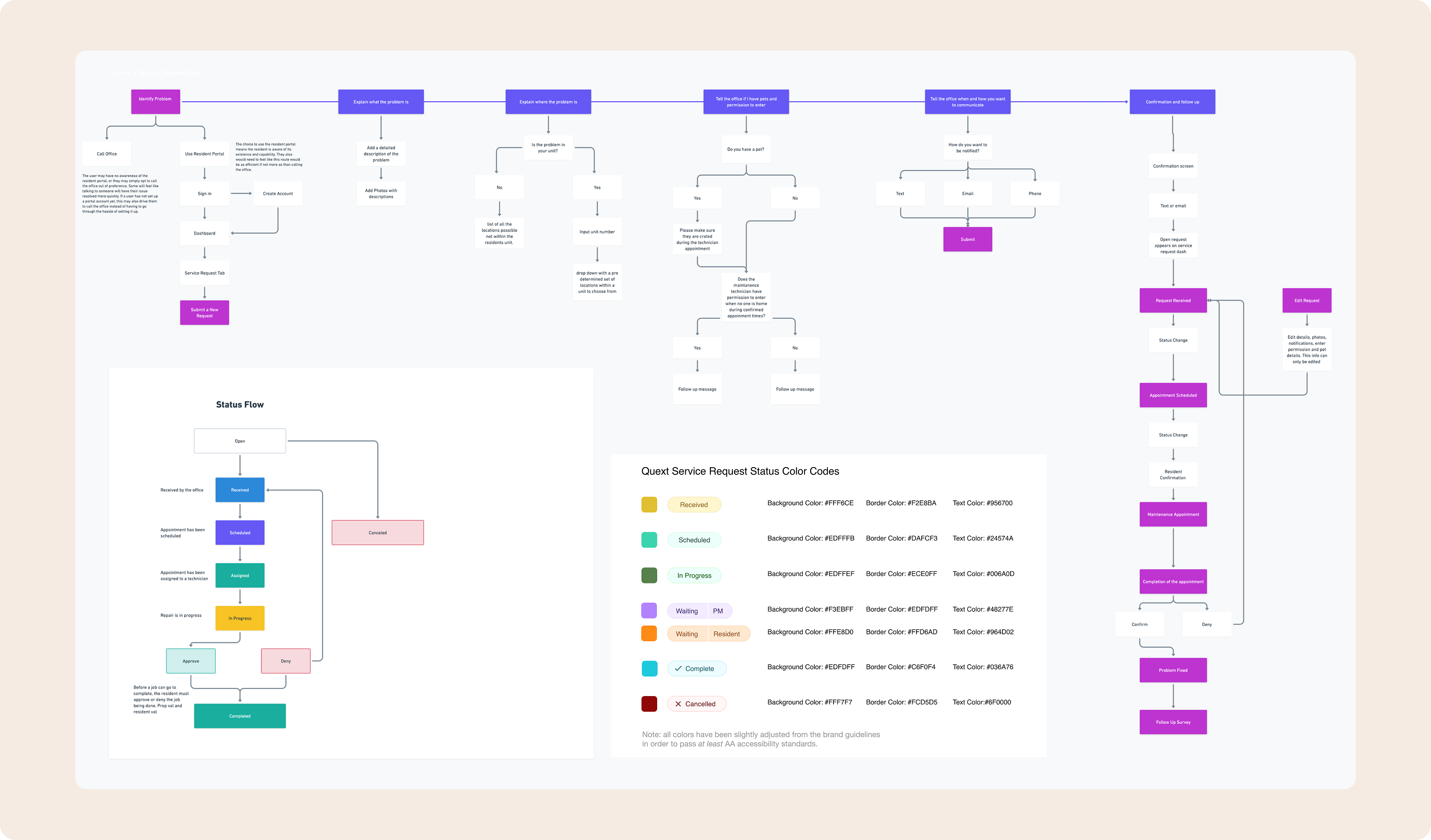
User Research
UX Design
UI Design
Prototyping
UX Design Lead (me)
Product Owner
Senior Developer
Engineering Lead
Project Manager
Engineering Lead
Front End Developer
QA Engineer
Back End Developer
Project Manager
CTO

Quext is a property management software and the smart-building / property technology arm of Madera Residential built to modernize over 120 properties such as apartments and multi-family communities.
As a part of this modernization, Quext sought to build a resident portal web and mobile application for residents to manage aspects of their renting experience.
Quext aims to use a resident portal application to improve the renting experience, and to improve front office efficiency.
• Automate rent collection, maintenance requests, and lease renewals to reduce staff workload and manual processing.
• Centralize communication and documentation between residents, property managers, and maintenance teams.
• Provide a self-service option for paying rent, reporting issues, and accessing community updates. Make these the default option for residents.
• Improve response times and transparency in service requests and other resident issues to build trust and loyalty.
• Minimize paper-based workflows, late payments, and data entry mistakes.
• Integrate with accounting, CRM, and IoT systems to streamline data flow.

For this case study, the focus is service request process of the Resident Portalspecifically how residents identify an issue in their unit and request maintenance from the front office.
Currently, no digital solution exists to manage this process online. Across the 120 properties Quext manages, maintenance requests are handled manually, typically over the phone or through in-person submissions.
This project explores how we digitized the workflow, enabling residents to easily submit requests, schedule maintenance, receive status updates, and communicate with the front office until the issue is resolved, all within their resident portal application.
What makes service requests frustrating for the resident and front office?
For residents, frustrations center around lack of transparency and communication in the maintenance process. Requests are often delayed, untracked, or unresolved, leaving residents unsure when or if the issue will be addressed. The process of scheduling a fix is inconsistent and time-consuming, with little visibility into progress or expected timelines.
For the front office, challenges stem from the manual and fragmented nature of managing service requests. With no centralized digital system, staff must juggle high volumes of requests across multiple channels from calls, emails, and walk-ins, making it difficult to track progress, coordinate with maintenance teams, or communicate efficiently with residents. The lack of structure leads to longer resolution times and increased operational strain.
As part of understanding residents’ broader renting experience, I surveyed people with experience using a resident portal to learn how often they access their resident portal, what device they use (desktop or mobile), and which features they find most or least useful.
I also focused specifically on the service request process to identify what aspects residents value most, what causes frustration, and what features they expect to make maintenance requests faster, clearer, and easier to manage.
This research was conducted in order to inform and validate the features, and to inform where to focus our design and development efforts in order to make the most impact for the resident.
The survey was distributed across multiple channels, including social media and online forums where discussions centered on renting, as well as directly to current residents of Quext properties. It focused on collecting quantitative data about how residents use the portal as part of their overall renting experience. I focused on frequency of use, access methods, and the broader context in which the Resident Portal fits into their daily interactions with property management.
• 71% of residents use a mobile device to access their resident portal
• 67% of residents reported a lack of transparency in service requests
• 62% of residents reported a lack of communication in service requests
In addition to the survey, I conducted qualitative interviews with 10 participants to deepen our understanding of the initial insights gathered. These conversations were designed to explore the why behind residents’ experiences, uncovering what aspects of the portal they found most useful, as well as their key frustrations and pain points. The findings from these interviews helped pinpoint where to focus our design and development efforts to create the greatest impact for residents and property teams.
• One common theme uncovered is that service requests is one of the most frustrating and memorable aspects of renting. Akin to a make or break moment for the larger renting experience.
• There is a lack of clarity around when the maintenance appointment is going to be, leading to stress for the resident.
• Another theme is residents reporting maintenance not coming prepared to fix the issue and having to come back, sometimes multiple times, leading to it taking longer than expected.
What do we need to build in order to create the most value for residents?
Following user research and building off of our insights, we identified design approaches to create the most impact for residents and for the business. These solutions were primarily aimed at improving feedback, communication, and transparency in the service request process.
Allow the resident, front office, and maintenance to communicate within the service request itself through notes and chat, improving clarity and reducing miscommunication.
Develop a clear system of service request statuses from open to closed. Offer a way for the user to see what the status of their request is
Structure the content around what it's like to do a service request in person, like the system in the front office. For example, let's ask, "What's the problem in your unit" and "How would you like to be notified about updates"?
First, we aligned around the ideal-state user journey for submitting a service request, mapping every step from issue identification to resolution. This process helped clarify the user’s point of view, key decision points, and moments of friction, while also defining what a smooth, transparent, and efficient end-to-end experience should look like for both residents and the front office.

This phase focused on mapping the user flows from a high level to define how the service request process would function end to end. It was a critical step, as the experience needed to integrate with the core property management system and align with existing service request statuses on the backend.
The process was highly collaborative, involving both the Quext team and our internal team to ensure the flows supported core functionality, user goals, and system requirements while maintaining technical feasibility.

The next step in the process was wireframing, translating the mapped flows into something a little more visual. This stage was also highly collaborative, focused on aligning the team around structure, functionality, and feasibility.
We worked closely with domain experts from Quext, validating design decisions with the Director of Product, property managers, and active users of the Quext system. The goal was to ensure the designs were both technically sound and reflective of actual user needs before moving into high-fidelity design.

In the next step of the process, we translated approved wireframes into high-fidelity UI designs and a scalable design system.
Our focus was on balancing accessibility and aesthetic, ensuring the design was reflective of our core user demographics, while achieving a modern, distinct visual identity to set Quext apart in the property management space.
This phase was a close collaboration between myself and a UI designer, working together to define the visual direction and build a scalable, consistent design system to support future growth of the Quext ecosystem.

The final phase centered on close collaboration between design and development within an Agile framework. Working alongside the development team, I supported implementation through detailed design documentation, design system guidelines, and regular walkthroughs and reviews.
My role also included QA and ongoing design support to ensure the quality of the output. This collaborative process helped us launch aligned with user needs and market expectations.

If the new service request process did one thing and one thing well, it improved communication between the front office and residents. We successfully took a previously manual process, and provided a digital solution that improved operational effeciency, and resident satisfaction.
Enabled clear, two-way communication between residents and the front office throughout the service request process.
Provided real-time visibility into request status, updates, and completion, creating trust and reducing uncertainty.
Unified workflows for maintenance and property staff, reducing delays and manual tracking while speeding up issue resolution.